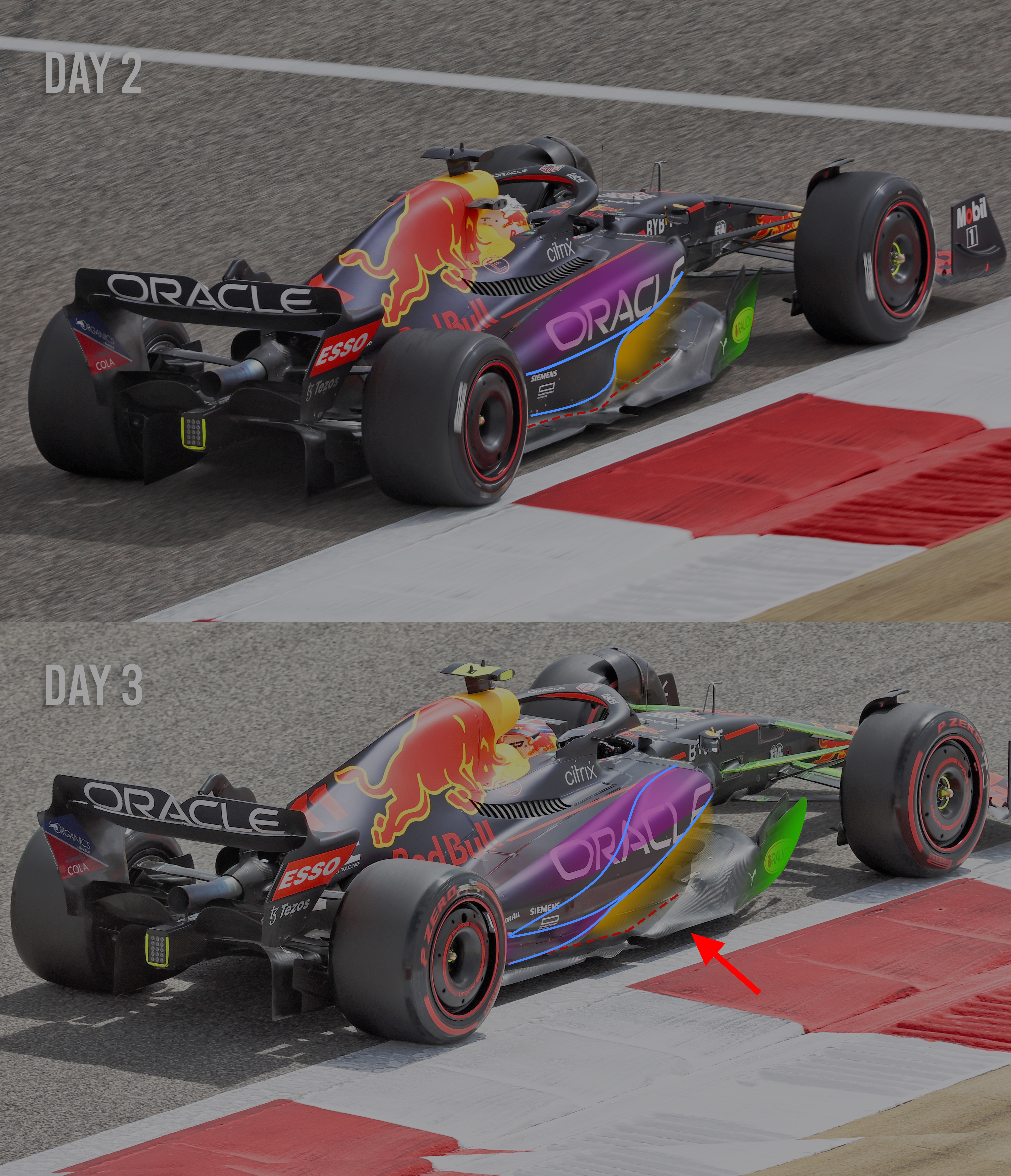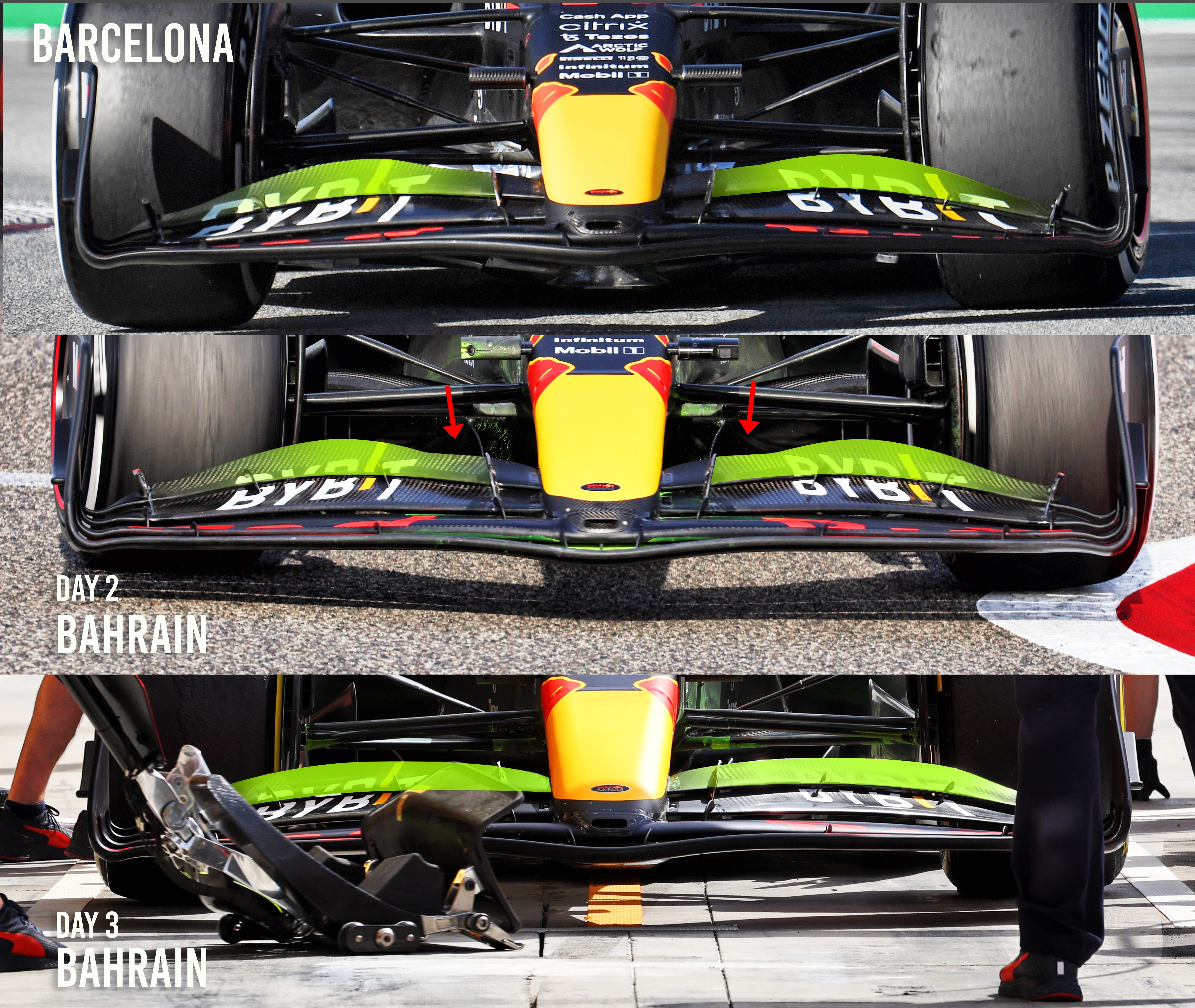Red Bull ended the Bahrain Formula 1 test on top both on single-lap and long-run pace, with its performance helped by an upgrade package reckoned to be worth as much as half-a-second per lap.
The upgrade was talked up ahead of its introduction as a brand new sidepod package, but in reality it was simply an evolution of what Red Bull already had.
That’s encouraging as on the last day of testing you don’t really want to be introducing a new concept and hoping it works immediately. Instead, this built on the strengths of the package of the initial Red Bull RB18 and made it better.
SIDEPODS

The sidepods are the most obvious change. The top surface is now less square and has been reshaped to be much more progressive and three-dimensional.
As part of that, there’s now a downwash channel created that sweeps the airflow down into the Coke bottle area (blue lines). It’s all about getting more airflow through the Coke bottle area and it’s what every team is trying to do regardless of their individual concept.
The undercut is a little more progressive, which ensures that there is a less sharp turn in the sidepods and more of a straight line as it heads back. If you look at our illustration showing the shape where the sidepod meets the floor (red dotted lines), you can see this reshaping clearly.
While the changes won’t transform the airflow, I’ve annotated the comparison of the original specification of sidepods compared to the new one to give an idea of how it will have changed.
FLOOR
The floor has also changed as part of the package. At the front of the floor, the outer bargeboard-replacement vane has been turned in a little at the lower leading edge and bottom edge.
This vane picks up the airflow coming around the inside of the tyre and, with the aid of the low pressure behind the front tyre, it helps create outwash which in turn helps generate the vortices that seal the floor further rearward.
These vortices are then further enhanced using the turning vanes/splitters that are in the throat area of the underfloor, they curve around and their trailing edge is just inside the outer edge of the front part of the underfloor (red arrow in the drawing above).
There also appears to have been some reinforcement of the outer floor edge further back, which is no surprise given the potential for damaging these low-slung, highly loaded floors.
At the rear, the ramp on the inboard side of the floor that sweeps up to the top surface of the diffuser starts a little earlier. This will be to make it more sympathetic to the airflow on the top surface in this area, and is important to allow the vortices traveling down the sides of the floor to generate without being disturbed by step changes in the floor surface.
One thing I noticed about the floor was that the Red Bull did show signs of the old Adrian Newey trait of the increased rake.
The RB18 seems to have the porpoising under control without sacrificing much performance, so perhaps this is something that allows it to do so? If you can keep the rear from dropping too low at high speed, it should stay clear of the ground and therefore avoid problems with stalling.
FRONT WING

Red Bull’s Saturday upgrade included a modified front wing that wasn’t a dramatic change, but was all about continuing to optimise the trim detail of the trailing edge of the top/rear flap.
The airflow coming off this affects the car further downstream. This means that as you gather more data on where that airflow is travelling to you can influence it slightly by changing how it loads up the front wing.
To understand what Red Bull is doing, we can look back to the evolution of this front wing since Barcelona. The first version was a relatively conventional 2022 concept. The load increases as the wing moves outboard from the nose, with the maximum load approximately at the mid-point span wise.
Red Bull then changed this to reduce the inboard load further (red arrow). This wouldn’t necessarily induce better flow in this area, but there would be a little more transverse flow on the undersurface outwards to the part of the flap with the longest chord length.
This will increase the flow that is turned outwards from underneath the chassis and around the front corner of the sidepods and in turn that slightly repositioned outer bargeboard vane. Teams are working hard to find ways to create or increase the outwash effects in certain areas, and this was presumably felt to be a way to add to that.
Perhaps Red Bull found it had gone too far with this, as the Bahrain day-three version switched to a more uniform load distribution that would induce less transverse flow.
There will be many other subtle parts to this upgrade as it’s all about refining the airflow to make the car concept that Red Bull started with work better, once you have understood if your car correlates on track with your design philosophy, windtunnel and CFD findings then you are on your way to improving its performance.
The fact it bolted it all on the car on Saturday and ended up fastest with a car that looks well-balanced on track and that it appears to understand is very encouraging for the team.




